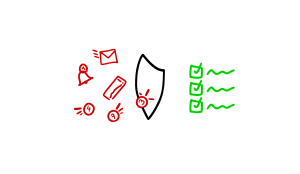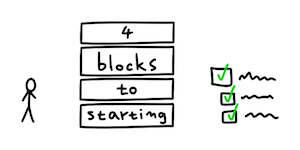Why you should practice voluntary discomfort to become happier

Do you like being comfortable? Most of us do.
What if we told you that getting uncomfortable once in a while is one of the best things you can do for yourself?
This is where voluntary discomfort comes into place.
What is voluntary discomfort?
You take a cold shower instead of a hot one. You decide to walk instead of driving a car. You ask for a discount at a coffee shop.
You expose yourself to some kind of discomfort voluntarily. It can be physical or mental.
Why is voluntary discomfort good?
The first question to answer is why would one seek out discomfort voluntarily?
Isn’t the point of society trying to be comfortable?
People invented elevators so we don’t have to walk the stairs, air conditioning so we don’t have to deal with being hot, washing machines so we don’t have to wash our clothes manually.
However, being too comfortable all the time makes you unprepared for dealing with problems that come at you involuntarily.
The whole philosophy behind voluntary discomfort is about suffering. It’s coming and you better be ready. Let us elaborate.
The assumption is that life is full of suffering and we can’t escape suffering. Sometimes you can postpone it but it is unavoidable. Sh*t happens: you get sick, you get fired, someone might die in your family tragically.
This isn’t to make you worry though… No, it’s about preparation. The better you become, the more able you’ll be to deal with the suffering when it does come.
Voluntary discomfort makes it so you’re the person that can handle it, stay cool, and solve the problems. On the other hand, being too comfortable makes you unable to solve these problems. It makes you weak. Every little issue becomes a big one.
Life doesn’t get easier, you get better. If you make a habit of embracing discomfort of your own will, the things that seemed difficult in the past will become easy for you.
The mindset behind all this is about doing difficult things now will make things easier in the future.
The benefits of voluntary discomfort
Voluntary discomfort = the path to mastery
Let’s take a simple example.
Say you’re going around a lake in cold winter weather - if you fall into the lake with no training, you panic, and you will fight for your life. You start hyperventilating. You enter fight or flight mode as prey.
However, if you decide to go into the lake voluntarily, you choose the path of exploration and mastery. Yes, it will feel uncomfortable, but you’re able to calm yourself down. If you overcome the first shock phase, you’ll become comfortable and enjoy it. You realize that cold water isn’t that terrible and it’s not something you have to be scared of.
Over time, discomfort might not be discomfort anymore. This is often called expanding your comfort zone. You’re expanding the zone of things that are under your control.
You build up resilience
We talked about how David Goggins has this unique skill of overcoming adversity.
If you practice being uncomfortable and you do it voluntarily, your brain changes over time. You become mentally tougher. It’s similar to when you’re building your muscles by working out. You build your brain by practicing voluntary discomfort. No, it doesn’t grow, but the neural pathways connected to dealing with hardships get strengthened.
So it’s easier to exert control the next time.
This makes you much more prepared for when you need it.
In comparison to voluntary discomfort, ordinary tasks will look like a joke.
Experiencing voluntary discomfort makes you worry less
Ancient stoics came up with the concept of voluntary discomfort. For example, even when being rich but living like poor would make you worry less about losing your fortune.
If you go for an intense hour-long run, minor tasks involving pressing some keys on your laptop seem like nothing.
It’s about the contrast. Without discomfort, it’s harder to understand how comfortable you typically are.
Also, when you train yourself through voluntary discomfort, you increase your stress threshold - the amount of adrenaline and cortisol in your system that you can handle. You train yourself to remain calm in your mind, even though your body is flooded with a cocktail of stress-related hormones.
This makes you better equipped to deal with all kinds of everyday annoyances. If you have a high stress threshold, the little things won’t faze you.
It makes you happier
First, after experiencing voluntary discomfort, returning back to the normal state feels amazing. Food after a 7 day water fast feels like paradise. Resting after running a marathon is so easy.
After stepping out of your comfort zone, you feel amazing afterward. Running a marathon isn’t usually fun, but it’s great in memory regardless. It’s something you can be proud of. It makes you feel like you spent your time well.
Not only this, It makes you more grateful for things you have. You stop taking things for granted anymore. After a long hike, cool water feels like a gift from gods, and even sleeping in a tent feels super soft.
Potential dangers
As usual, proponents of an argument forget to mention the potential downsides. They are real because we’ve experienced them both.
1. Overdoing it and endangering your life. There is a balance between giving up too soon and continuing until it costs you. I recommend erring on the side of caution because you can always take on more discomfort another day.
2. Leading to machoism and suppressing your emotions altogether instead of dealing with them. It’s one of the reasons why this philosophy gets a bad rap because it’s often being presented as either you can do it or you’re a wuss. If you can’t do something, you’re not a wuss… you were not ready yet, it was just too overwhelming.
Wherever you are on your journey, you can find a way to challenge yourself at the right level of difficulty. If you’ve never done any cold exposure, don’t jump straight into a frozen lake. There are levels to everything.
How to apply it in your life?
Voluntary discomfort is best practiced on a daily basis.
The following are general ideas that are good for practicing voluntary discomfort
Cold water exposure
The simplest (and thanks to the Wim Hof craze now also popular) is taking a cold shower or a bath.
It is uncomfortable, but it also gets easier over time and you can increase the difficulty - but it never gets super easy because the first moments are always uncomfortable. Those moments teach you to switch from automatically reacting to the cold, to being calm and even enjoying it.
Physical and endurance feats
It can be as simple as always taking the stairs instead of elevators, or walking instead of using your car.
Then the next level is doing a more demanding activity regularly:
- Working out regularly
- Taking martial arts classes
- Running or cycling
If you do an activity regularly and it isn’t discomforting anymore, maybe it’s a good idea to sign up for competition as a way to increase your commitment and training:
- A fight
- Powerlifting meet
- Obstacle course races
- Running a marathon
Now, like we said before - there are levels to everything. If you’ve never run a race, signing up for a 5k or 10k race is an optimal opportunity to push yourself a bit more.
Social interactions
The next great area is interacting with other people. We’re often uncomfortable interacting with strangers.
- Asking for advice while shopping
- Asking for a discount when buying a coffee
- Talking to a stranger while waiting in line
It’s a different kind of discomfort, but it works just as well.
Dealing with emotions actively
One of the best practices is to build your mental toolbox for handling emotions. For most people, it can be pretty discomforting at first to actively think about their emotions, which is why they avoid it. However, there’s a lot we can learn about ourselves from introspective activities such as:
- Daily journaling
- Falling asleep while not doing anything
- Meditation
- Going to psychotherapy
Everywhere else
When engaging in voluntary discomfort, treat everything as an experiment. Maybe the previously listed areas didn’t resonate with you. Look for these signs instead:
- Look for things where you’re too comfortable.
When you do something that is too automatic and easy, switch it up.
- Look for areas where you’re really uncomfortable.
Are you avoiding certain work? Use it as your voluntary discomfort experiment.
- Do month-long experiments.
Learn something you hate or know nothing about for a month.
Read about the idea here.Don’t you know anything about music? Learn about it for a month in your free time.
Give up Netflix/Gaming/Alcohol for a month.
- It’s also good to undertake larger experiments once in a while, to practice really being uncomfortable:
For example, I went from regular eating to intermittent fasting a long time ago.
After a while, I found out there was no discomfort anymore.
So I tried prolonged water fasting, first 3 days, then 5 days, and then 7 days… It was a totally new experience. Please, don’t endanger your life, also if you have any eating disorder, don’t try intermittent fasting.
Summary
Voluntary discomfort is one of the best tools one can use in personal growth. Though it can be dangerous, with sound judgment it’s the best way to learn to handle stress.
The idea behind it is that being too comfortable makes one unable to deal with real-life problems when they do come up (which they will). Eternal comfort also makes you less grateful for the things you have.
On the other hand, voluntary discomfort allows you to explore your potential and grow a little bit as a person.
What’s your next voluntary discomfort challenge?


